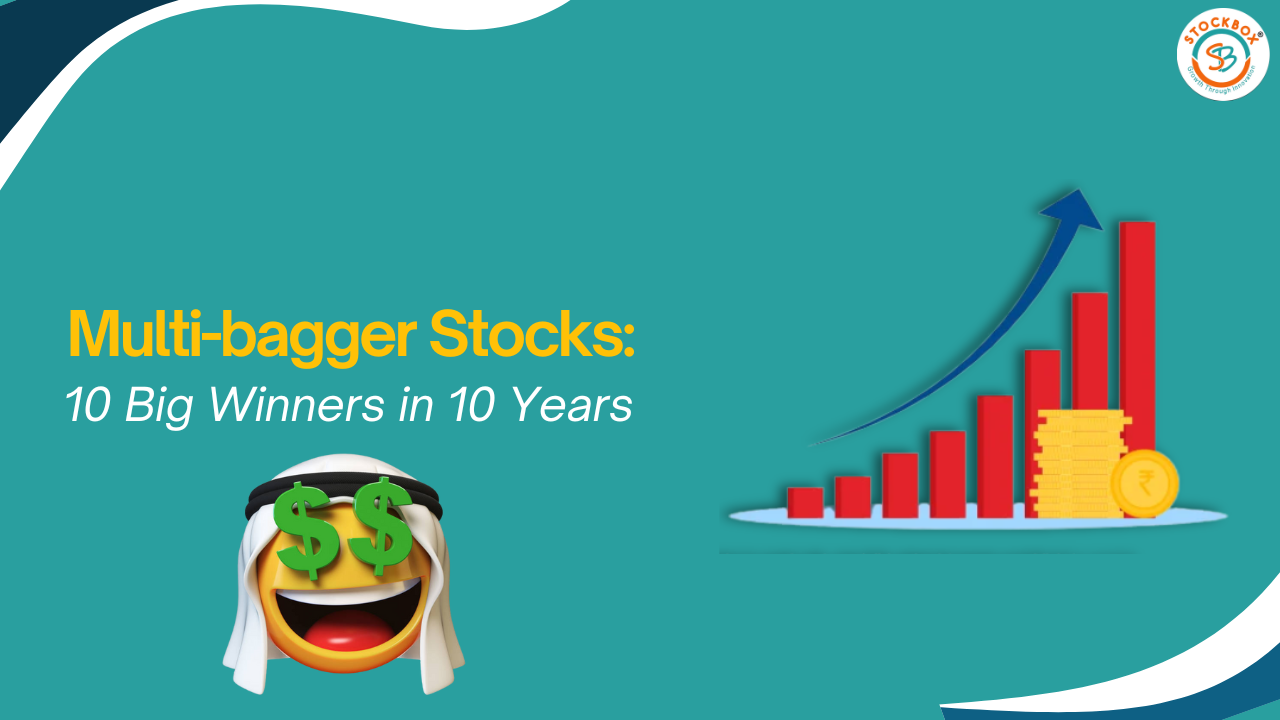Aren’t you curious about how some investors can multiply their wealth 10 times, 20 times, or more? The art lies in finding early multi-bagger stocks-the few and far-between opportunities that give exponential appreciation over time.
In this blog, we shall look into some 10 multi-bagger stocks in India over the past decade to see the commonalities these long-term winners share.
Meaning of a Multi-bagger Stock
A multi-bagger is a stock giving more than 100% return on investment. Suppose the price of the stock was ₹100 and it goes up to ₹500. Then, it is called a 5-bagger stock. Such stocks become sources of massive wealth over time. They do so by compounding earnings and investor trust.
10 Multi-bagger Stocks (2014–2024)
Here’s a list of Indian companies that turned into multi-baggers over the past 10 years:
| Stock Name | Price in 2014 | Price in May 2025 | Returns (Approx.) |
| Tata Elxsi | ₹140 | ₹5,728.50 | 3980% |
| Avanti Feeds | ₹30 | ₹854.50 | 2748% |
| Caplin Point Labs | ₹30 | ₹1,852.70 | 6076% |
| Deepak Nitrite | ₹65 | ₹1,951.90 | 2902% |
| La Opala RG | ₹40 | ₹231.81 | 479% |
| Relaxo Footwear | ₹95 | ₹404.80 | 326% |
| KEI Industries | ₹30 | ₹3,193.90 | 10,546% |
| Dixon Technologies | ₹500 | ₹15,930.00 | 3086% |
| Tanla Platforms | ₹5 | ₹466.75 | 9235% |
| Bajaj Finance | ₹200 | ₹8,860.00 | 4330% |
What These Stocks Shared
Now let us unravel the winning formula behind these multi-baggers:
1. Strong Fundamentals
Each stock on this list exhibited:
- Steady revenue growth
- Increasing net profit margins
- Low debt levels or no debt
Example: Deepak Nitrite recorded linear growth in EBITDA margins and had healthy net free cash flow.
2. High ROE & ROCE
Return on Equity (ROE) and Return on Capital Employed (ROCE), whenever calculated, were consistently above 15-20%, a clear indication of capital use efficiency.
Example: In a rare performance in the NBFC sector, Bajaj Finance has consistently delivered ROE in excess of 20%.
3. Small to Mid-Cap Beginnings
Most multi-baggers started as small or mid-cap stocks. And with their growth, the market began to re-rate them, bringing a lot of upside potential.
Insight: Multi-baggers come mostly from relatively smaller companies rather than the blue-chip stocks.
4. Industry Tailwinds
These companies operated in high-growth areas:
- As FMCG (La Opala)
- Pharma (Caplin Point)
- Chemicals (Deepak Nitrite)
- Technology (Tanla, Tata Elxsi)
Tip: Identify companies operating in sectors that are booming on account of global or governmental support.
5. Visionary Management
One of the defining characteristics of these companies was clean and competent management that had a long-term vision along with shareholder friendliness and ethical governance.
Example: KEI Industries developed strongly under strategic leadership by consistently expanding capacities and reducing debt.
6. Product or Service Differentiation
Companies with a unique product, monopoly, or superior branding had pricing power and margin protection.
Key Learnings for Aspiring Investors
- Look outside the big caps: small companies with good fundamentals could offer larger upside.
- Focus on quality, not price: cheap stocks are not always good, and good stocks are not always cheap.
- Time in the market is paramount: most multi-baggers tend to really take 5 to 10 years to explode.
- Take a stance: patience, coupled with research, will be your greatest friend.
Conclusion
Finding the next multi-bagger isn’t luck—it’s discipline, research, and patience. There is no guarantee, but studying past winners can hone your vision toward future opportunities.
Start small. Stay consistent. Think long. That’s the recipe for multi-baggers.
- India’s $5 Trillion Economy in 2025: Stock Market Impact & Sector Outlook
- 5 INVESTMENT TRAP PEOPLE FALL FOR
- Reliance Industries Success Story: From Textile to Stock Market Titan
- The Inspiring Story of ITC Limited: From Tobacco to Conglomerate
- HDB Financial Services IPO 2025: Dates, Details, Financials & Should You Invest?

